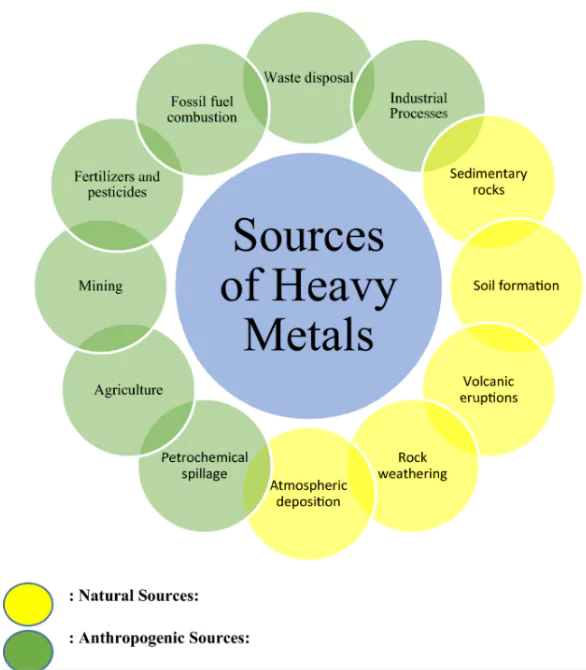A recent report by the Central Water Commission (CWC) highlights the alarming levels of heavy metal contamination in Indian rivers.
Heavy Metal Contamination in 81 Indian Rivers
- Toxic Metals Detected: Metals beyond safe limits include arsenic, cadmium, chromium, copper, iron, lead, mercury, and nickel.
- Rivers Affected: A total of 81 rivers and tributaries in India have high concentrations of one or more toxic heavy metals.
- Extent of the Problem
- Monitoring Data: 141 out of 328 monitoring stations (43%) across 81 rivers showed toxic metal levels beyond acceptable limits.
- Geographical Spread: These stations span 13 states and 99 districts, with Uttar Pradesh having the highest arsenic levels, particularly in the Ganga and Gomti rivers.

What is Heavy metal?
- It typically refers to dense metals that are toxic, even at low concentrations.
- Typical Features of Heavy Metals
- High Atomic Weight: Heavy metals usually have a high atomic number and atomic weight.
- Specific Gravity: These metals often have a specific gravity greater than 5.0, meaning they are very dense.
- Diverse Groups: Heavy metals include different categories like metalloids, transition metals, basic metals, lanthanides, and actinides.
Enroll now for UPSC Online Course
Key findings of the report
| Metal |
Major Health Risks |
| Arsenic |
Cancer, cardiovascular disease, dermatitis, lung and brain issues |
| Cadmium |
Kidney damage, cardiovascular disease |
| Chromium |
Lung cancer, respiratory issues |
| Copper |
Liver and kidney damage (when excessive) |
| Iron |
Iron overload disorders (when excessive) |
| Lead |
Nervous system damage, brain damage, other organ damage |
| Mercury |
Nervous system damage, kidney damage, brain damage |
| Nickel |
Skin allergies, respiratory problems |
-
- Key Metals: Arsenic, mercury, and chromium were detected across many rivers. For example:
- Arsenic: Exceeded limits at 30 stations.
- Mercury: Found above safe levels in 18 stations.
- Chromium: Exceeded limits at 16 stations.
- Specific Areas:
- In Uttarkashi (Bhagirathi river), arsenic, lead, and iron were detected.
- In Karnataka’s Honnali (Tungabhadra river), chromium, mercury, and lead exceeded safe limits.
- Kerala’s Madamon station had iron, mercury, lead, and nickel above the permissible limits.
- Sources of Contamination
- Human Activities: Heavy metals are introduced into rivers due to:
- Metal mining and smelting industries.
- Agricultural runoff, including fertilizers and animal waste.
- Urban runoff, industrial waste, and landfill leachates.
- Natural Sources: Natural deposits and erosion also contribute to metal levels.
- Impact on Flora and Fauna
- Non-Biodegradable Metals: Heavy metals, once present in water, do not break down easily. This poses significant threats to plants and animals.
- Crop Contamination: Crops such as grains and vegetables, grown in contaminated soil and water, can absorb these metals, leading to harmful effects.
- Health Risks to Humans
- Essential and Toxic Metals: Metals like copper are necessary for human health in trace amounts but can become toxic in higher concentrations. Others, like mercury, cadmium, and lead, are directly harmful even in small amounts.
- Toxicity and Bioaccumulation: Heavy metals are toxic and do not decompose, accumulating in organisms and leading to severe health problems for both humans and animals.
- Examples of Health Effects
- Arsenic Exposure: Drinking water contaminated with arsenic over time can cause skin lesions and a chronic illness known as arsenicosis.
- Cadmium Exposure: Even low exposure to cadmium can weaken bones and increase the risk of fractures and osteoporosis.
- Mercury Exposure: High levels of mercury can damage the nerves, brain, and kidneys, and cause symptoms like lung irritation, skin rashes, vomiting, and diarrhea.
Check Out UPSC CSE Books From PW Store
Mitigation and Solutions
- Need for Action: The report stresses the importance of addressing metal contamination through proactive measures.
- Stricter Regulations: Implement stricter regulations for industries and agricultural practices to reduce heavy metal discharge into water bodies.
- Environmental Impact Assessments: Require thorough environmental impact assessments for new industrial projects, especially those involving metals.
- Sustainable Practices: Promote sustainable agricultural practices that minimize the use of chemicals and fertilizers containing heavy metals.
- Technological Advancements
-
- Membrane Filtration: Employ advanced membrane filtration technologies to remove heavy metals from water.
- Nanotechnology: Utilize nanomaterials for efficient heavy metal removal and recovery
![]() 27 Aug 2024
27 Aug 2024

